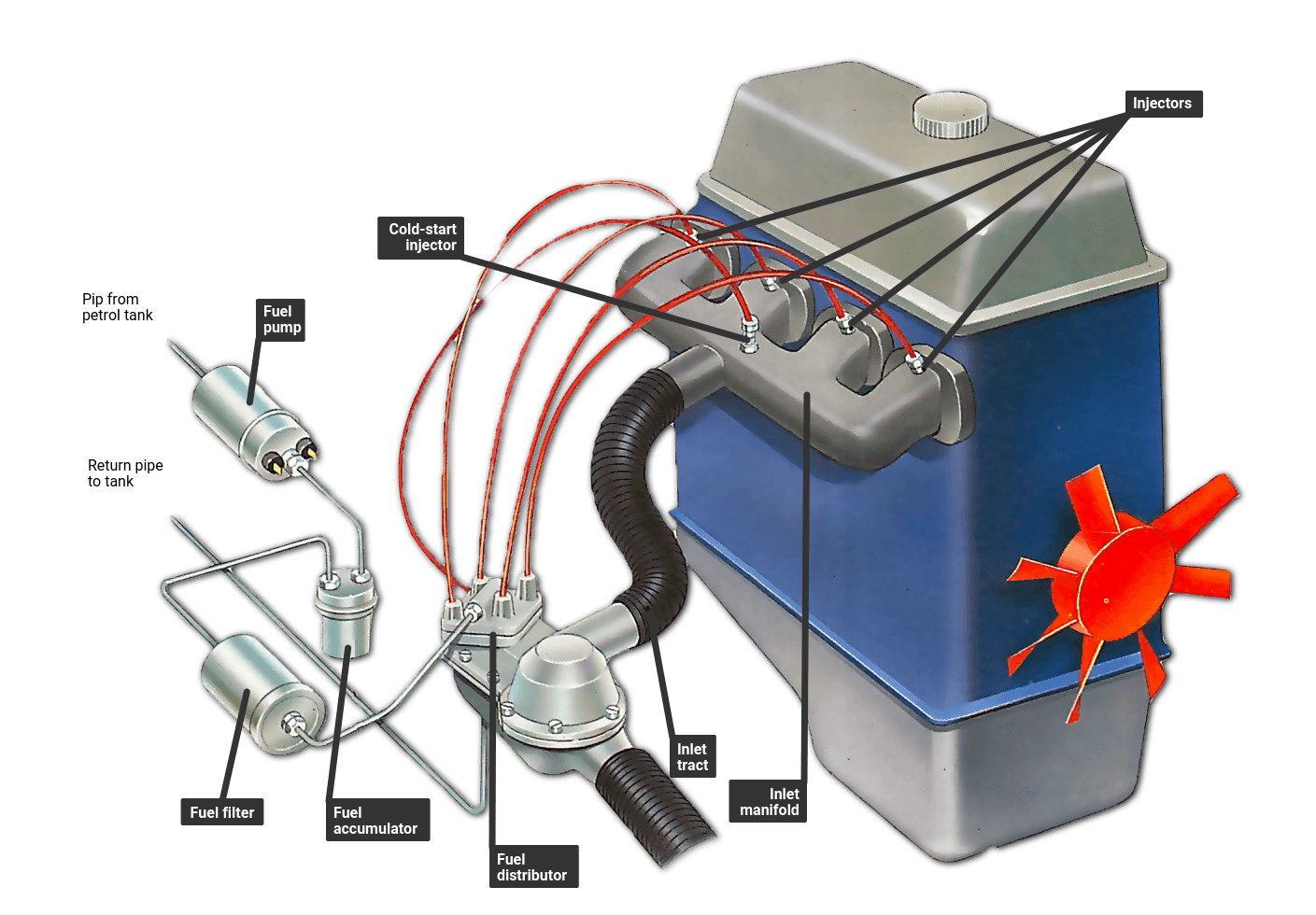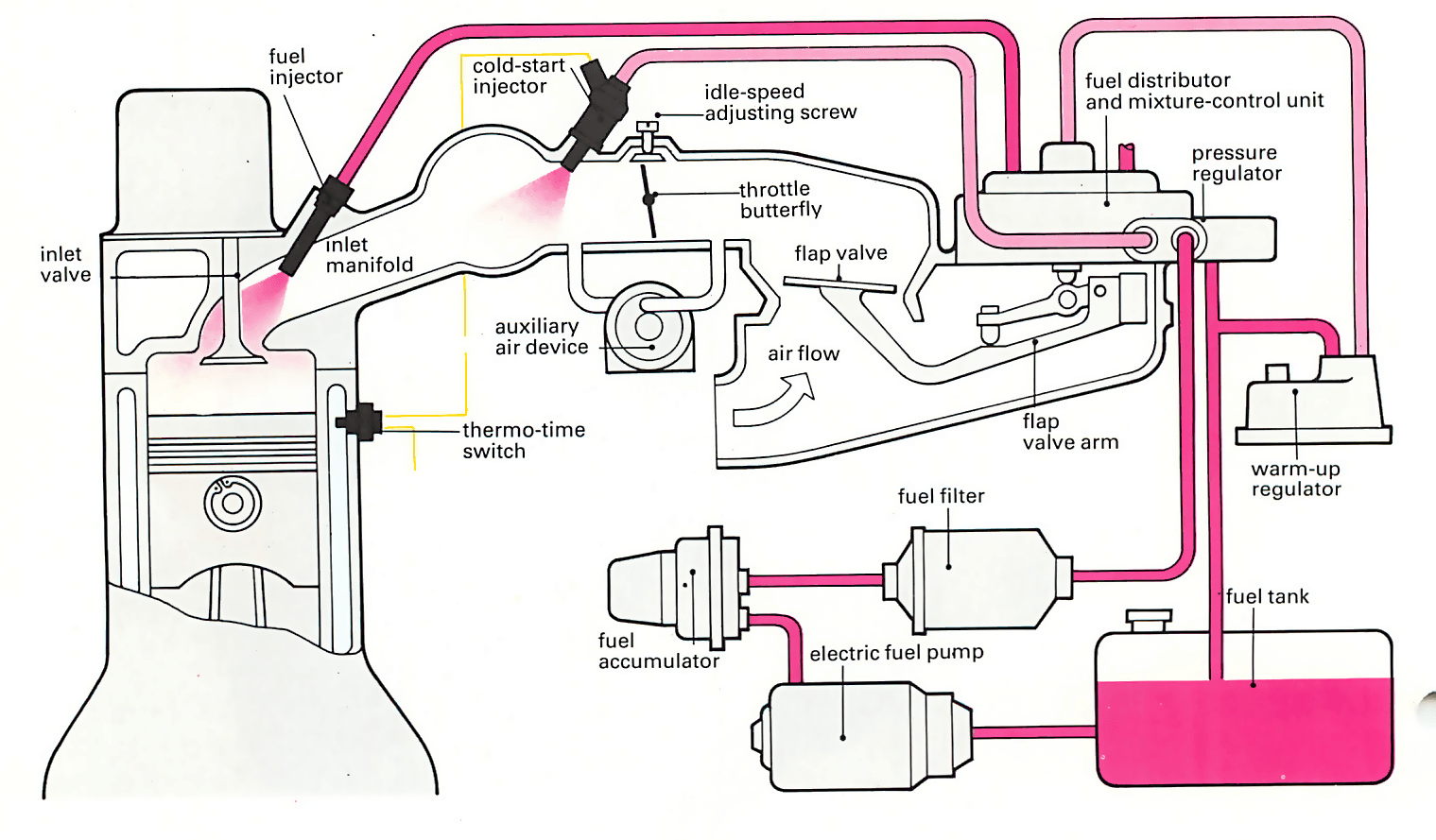How a fuel injection system works
The Video Course teaches you everything about modern cars.
For the engine to run smoothly and efficiently it needs to be provided with the right quantity of fuel /air mixture according to its wide range of demands.

Traditionally, the fuel/air mixture is controlled by the carburettor , an instrument that is by no means perfect.
Its major disadvantage is that a single carburettor supplying a four- cylinder engine cannot give each cylinder precisely the same fuel/air mixture because some of the cylinders are further away from the carburettor than others.
One solution is to fit twin-carburettors, but these are difficult to tune correctly. Instead, many cars are now being fitted with fuel-injected engines where the fuel is delivered in precise bursts. Engines so equipped are usually more efficient and more powerful than carburetted ones, and they can also be more economical, as well as having less poisonous emissions .
Diesel fuel injection
The fuel injection system in petrolengined cars is always indirect, petrol being injected into the inlet manifold or inlet port rather than directly into the combustion chambers . This ensures that the fuel is well mixed with the air before it enters the chamber.
Many diesel engines , however, use direct injection in which the diesel is injected directly into the cylinder filled with compressed air. Others use indirect injection in which the diesel fuel is injected into the specially shaped pre-combustion chamber which has a narrow passage connecting it to the cylinder head .
Only air is drawn into the cylinder. It is heated so much by compression that atomized fuel injected at the end of the compression stroke self-ignites.
Basic injection
All modern petrol injection systems use indirect injection. A special pump sends the fuel under pressure from the fuel tank to the engine bay where, still under pressure, it is distributed individually to each cylinder.
Depending on the particular system, the fuel is fired into either the inlet manifold or the inlet port via an injector . This works much like the spray nozzle of a hose , ensuring that the fuel comes out as a fine mist. The fuel mixes with the air passing through the inlet manifold or port and the fuel/air mixture enters the combustion chamber.
Some cars have multi-point fuel injection where each cylinder is fed by its own injector. This is complex and can be expensive. It's more common to have single-point injection where a single injector feeds all the cylinders, or to have one injector to every two cylinders.
Injectors
The injectors through which the fuel is sprayed are screwed, nozzle-first, into either the inlet manifold or the cylinder head and are angled so that the spray of fuel is fired towards the inlet valve .
The injectors are one of two types, depending on the injection system. The first system uses continuous injection where the fuel is squirted into the inlet port all the time the engine is running. The injector simply acts as a spray nozzle to break up the fuel into a fine spray - it doesn't actually control the fuel flow. The amount of fuel sprayed is increased or decreased by a mechanical or electrical control unit - in other words, it is just like turning a tap on and off.
The other popular system is timed injection (pulsed injection) where the fuel is delivered in bursts to coincide with the induction stroke of the cylinder. As with continuous injection, timed injection can also be controlled either mechanically or electronically.
The earliest systems were mechanically controlled. They are often called petrol injection (PI for short) and the fuel flow is controlled by a mechanical regulator assembly. These systems suffer from the drawbacks of being mechanically complex and having poor response to backing off the throttle.
Mechanical systems have now been largely superseded by electronic fuel injection (known as EFi for short). This is thanks to the increasing reliability and decreasing costs of electronic control systems.
Mechanical fuel injection

Mechanical fuel injection was used in the 1960s and 1970s by many manufacturers on their higher-performance sports cars and sports saloons. One type fitted to many British cars, including the Triumph TR6 PI and 2500 PI, was the Lucas PI system, which is a timed system.
A high-pressure electric fuel pump mounted near the fuel tank pumps fuel at a pressure of 100psi up to a fuel accumulator . This is basically a short-term reservoir that keeps the fuel-supply pressure constant and also irons out the pulses of fuel coming up from the pump.
From the accumulator , the fuel passes through a paper element filter and then feeds into the fuel-metering control unit, also known as the fuel distributor . This unit is driven from the camshaft and its job, as the name suggests, is to distribute the fuel to each cylinder, at the correct time and in the correct amounts.
The amount of fuel injected is controlled by a flap valve located in the engine's air intake. The flap sits beneath the control unit and rises and falls in response to airflow - as you open the throttle, the 'suck' from the cylinders increases the airflow and the flap rises. This alters the position of a shuttle valve within the metering control unit to allow more fuel to be squirted into the cylinders.
From the metering unit, the fuel is delivered to each of the injectors in turn. The fuel then squirts out into the inlet port in the cylinder head. Each injector contains a spring-loaded valve that is kept closed by its spring pressure. The valve only opens when the fuel is squirted in.
For cold starting, you cannot just block off part of the airflow to enrich the fuel/air mixture as you can with a carburettor. Instead a manual control on the dash (resembling a choke knob) or, on later models, a data-term-id="1915">microprocessor
The Ultimate Car Mechanics video course
Learn everything about modern cars from our new video series.
Learn more >-
We build a Mazda MX5 Miata from scratch
We start by tearing down and then rebuilding the whole car.
-
Every part explained
There's ridiculous detail on every part. Clearly and easily explained.
-
All modeled in 3D
We've created the most detailed 3D model ever produced so we can show you everything working.






